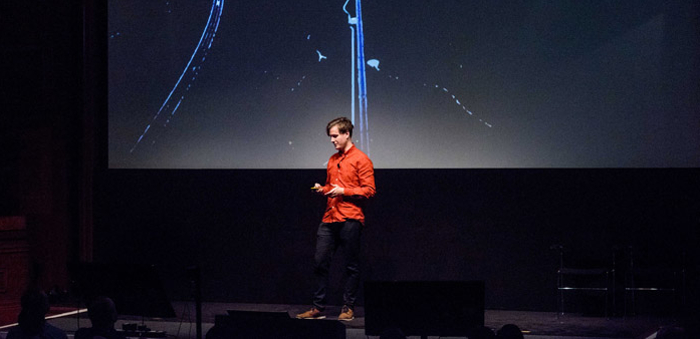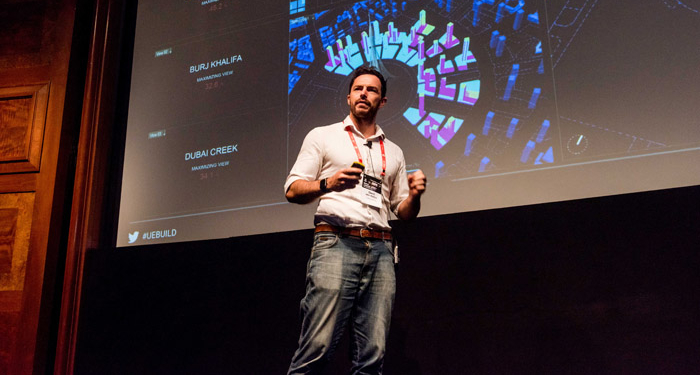Epic Games’ Build:London event has become an essential diary date for the AEC fraternity. There’s a great balance between showing real-world applications and giving insight into what’s coming next in Unreal Engine
There was a time when Virtual Reality was all hype; now it’s a reality in most of the major AEC firms. While VR is still used mainly as a customer-facing technology, there are a number of companies that are deploying it as a design tool, from concept through to validation.
Unreal Engine by Epic Games has been one of the driving forces behind the rise of VR in the AEC sector. This is mainly because the 3D engine can be used to create visually impressive, custom VR experiences, but it is also down to AEC-focused applications that are built on the 3D engine, such as Twinmotion, which Epic Games acquired earlier this year.
To support its growing community, Epic Games now hosts an annual London event focused specifically on the AEC market. Build:London showcases the breadth and depth of real-world applications from users of Unreal Engine as well as giving the community an opportunity to see new developments in the software.
The conference
The first presentation was an onstage interview with CG artist Alex Roman, creator of “The Third and Seventh”. Roman manages to create amazing, gobsmacking realism and cinematic beauty in his architectural CG visualisations and films, using V-Ray and Unreal. This was an impossibly high bar to match for rendering quality. Gabriele Sorrento, the CEO of
Mindesk then gave a presentation of Mindesk Bridge, a VR design tool for McNeel Rhino and Solidworks. While the software can be used to model geometry in VR, at the moment the most common way to use it is as a design review tool. Assemblies are imported and the application allows control over transparency of objects, ‘explosion’ of assemblies and even kinematic movement, all in VR.
Sorrento was joined by Helmut Kinzler and Aleksandra Mnich from Zaha Hadid Architects to show how they used Mindesk with Rhino to explore a project they had recently worked on, the L-Acoustics ‘Loop Sound lounge’ chair. Mnich gave a live demonstration of geometry creation, creating surfaces to complete an enclosure. As with many live demos, unfortunately it didn’t work for long, so they defaulted to a canned video but kudos for trying!
Aaron Perry of Allford Hall Monaghan Morris (AHMM) gave a fascinating talk about the impact and evolution of using the real-time engine in the whole architectural lifecycle. One of the more impressive uses of Unreal showed how the company uses a giant 3D model of London to place their various project buildings and explore all aspects of their design in context. Within the model, which is many square kilometres in size, it is still possible to go from flying above the blocks and streets, and then into the lobby of a project building to explore the design – all in real time. An impressive display of both scale and detail.
John Murphy, Creative Director / Motion at the BBC talked on its design and deployment of the “Match of the Day” virtual set, which uses a green screen studio with an Unreal virtual overlay. Gary Lineker has never looked more weird in a sea of green and one can only imagine how hard that would be to do. It’s been such a success for the BBC they are thinking they might just green screen the pundits at major sporting events and save on not building sets around the world.
David Weir-McCall of design practice CallisonRTKL took us in a different direction and demonstrated how the firm uses Unreal Engine and immersive techniques to gather data and better understand how people react to their designs for sustainability, value engineering and façade development design.
In each individual VR experience, user position, target position, viewer angle, and direction of travel are all collected to see how people react in the spaces, where they go, where they don’t go, what they avoid and what they look at. This creates heat maps in the digital space and can inform the designers how a space works. It can be used with a Digital Twin of an as-built, as well as proposed changes or new builds. In terms of modelling at a country scale, Ludvig Loven of AF Consult blew the barn doors off. The impressive demonstration detailed how the firm built and modelled an area around Stockholm, comprising thousands of square kilometres, in Unreal Engine for a proposed train line (160km of track, 200 bridges with 30 tunnels). Within a few seconds we went from soaring above in orbit to resting on the grass, next to the train tracks, alongside a bunny rabbit. We also saw multiple designers interactively create a road in VR, in real-time, across dozens of kilometres of Sweden. In terms of detail on a grand scale, a team from Tencent shared how they’ve built an impressive ‘Digital Twin’ of Shanghai using Datasmith and Unreal Engine.
Henry Richardson, Professor of Architecture at Cornell School of Architecture, spoke on the impact of Unreal Engine in teaching urban design.

Twinmotion
Twinmotion was acquired by Epic Games earlier this year and it always demonstrates well. With the company’s new-found partnership with Graphisoft, Twinmotion was given an ArchiCAD model to populate. With the rich component library and environments applied with simple sliders, the proposed project area was brought to life. With street furniture, trees, cars, flocks of birds and people we were taken through all the seasons. For architects, it’s like the best SimCity ever made.
Coming next
In a fleeting couple of images, we saw some interior and exterior laser scans comprising billions of points imported and rendered in Unreal. This is not a small undertaking, as laser scan files are extremely heavy on data. This will be coming soon, as Unreal continues to focus on being able to integrate common AEC formats.
We were also treated to a sneak-peek at early development work on a core geometry modelling engine that’s being created inside Unreal Engine. It looked to be powerful and intuitive (push/pull driven) and capable of making complex forms. This should be an interesting direction for the company.
The next release will also have a real physical sky and while Unreal is all about real-time, the release will be able to render super high resolution 20k in a non-real-time mode.
Conclusion
The running themes and messages from the talks were that Unreal Engine can handle huge models of detailed landscape. It eats complex geometry without any impact on the frame rate and speed of experience. Frankly it seems like CG alchemy!
It’s clear that there is a trend to deploy VR in conceptual design, model checking, data analysis, training and experimentation. By moving VR from a backend to a front-end tool, early adopters are finding useful insight into their designs. Virtual Reality is in itself a design application not just an experience. However, we have yet to be convinced that accurate surface modelling in VR with current input and manipulation wands can compete with a mouse or pen-based desktop system, but it’s not stopping people from trying.
What seems to work the best is if the models are blocks, like Minecraft, so perhaps massing will become increasingly popular.
If you enjoyed this article, subscribe to our email newsletter or print / PDF magazine for FREE






